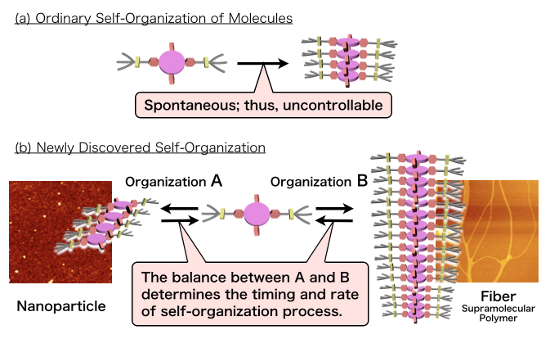World’s First Success in Controlling the ‘Length’ of Supramolecular Polymers through Self-Organization
A great step forward toward the development of a new synthetic method that leads to unprecedented materials in polymer science and nanotechnology
National Institute for Materials Science (NIMS)
The National Institute of Materials Science (NIMS) developed a method for controlling the molecular self-organization, the process that is significant for synthesizing functional materials, and succeeded for the first time in the world in controlling the length of a one-dimensional assembly of molecules (supramolecular polymer).
Abstract
- A team of researchers of the Polymer Materials Unit (Unit Director: Izumi Ichinose) of the Advanced Key Technologies Division of the National Institute of Materials Science (NIMS; President: Sukekatsu Ushioda) discovered that in the process of the self-organization of molecules into a one-dimensional molecular assembly (supramolecular polymer), several different self-organization pathways interplayed. By making use of this phenomenon, they succeeded in controlling the length of a supramolecular polymer.
- The phenomenon in which molecules self-organize (self-organization) is a significant process to synthesize a new type of functional polymers called supramolecular polymers. However, it has been difficult to control this process at will because it proceeds spontaneously. In contrast, in the conventional polymer synthesis, a technique called living polymerization enables the precise control over the length of the polymer to be synthesized, and it has been widely used in industry. However, there has been no equivalent to this technique available for synthesizing supramolecular polymers through the self-organization of molecules.
- In general, self-organization proceeds from a molecularly dispersed state to an organized state through a single pathway. The research team synthesized new functional molecules and discovered that two self-organization pathways interplay each other when the molecules self-organize. They found that the mechanism behind this process is similar to that of living polymerization, which has been conventionally applied in polymer synthesis. Using this understanding of the mechanism taking place, they succeeded for the first time in the world in controlling the length of the supramolecular polymers produced through self-organization.
- Self-organization is a concept of extreme importance in a wide range of interdisciplinary fields covering materials science, nanotechology and biotechnology, and it attracts great attention as a new method of material synthesis. With vigorous research going on with regard to the properties and functions of new materials produced through self-organization, the research team has found a method of controlling the ‘length’ of supramolecular polymers, which is one of the most fundamental structural parameters in material design. The research results are expected to bring about new developments in basic and applied research based on self-organization.
- The research results had been published in the online version of a UK science journal, Nature Chemistry (S. Ogi, K. Sugiyasu,* S. Manna, S. Samitsu, M. Takeuchi* “Living supramolecular polymerization realized through a biomimetic approach” Nature Chemistry, DOI: 10.1038/NCHEM.1849)

Figure 1: Diagram of self-organization
(a) In general, self-organization process cannot be controlled as it proceeds spontaneously. (b) In the self-organization process newly discovered, two self-organization pathways (A and B) interplayed. By tuning the balance between such pathways, the research team succeeded in controlling the timing and rate of the self-organization process. The photographs in the diagram are atomic force microscope images.